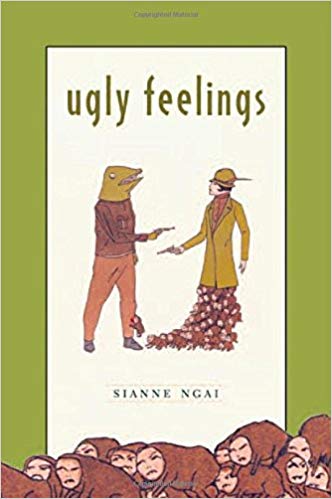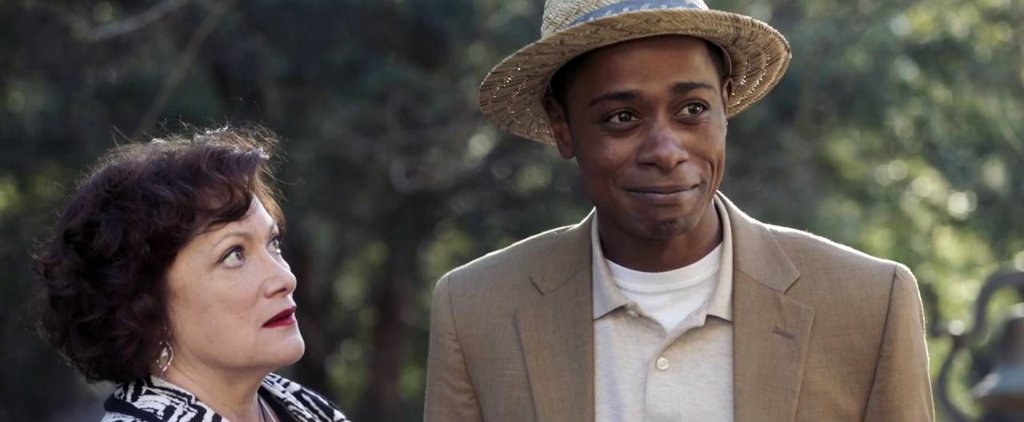Thesis
Ugly Feelings explores a selection of negative feelings as represented in literature and film. These feelings include: envy, anxiety, paranoia, irritation, “animatedness,” and “stuplimity” (though, for this list, I’ve chosen to focus only on paranoia, animatedness, and stuplimity). Ugly feelings are less pronounced and less powerful than the “higher” passions like anger or fear. They are not always articulated clearly, and are often characterized by ambiguity, ambivalence, and a lack of agency (2-3). They are non-cathartic and typically signify entanglement or stasis (3-4). They also sometimes occur as somewhat ironic meta-feelings, or feelings about feelings (i.e.: I feel shame about my feeling envious) (10).
Ngai explores these ugly feelings because for her, they are political: They are “unusually knotted or condensed interpretations” of material, social, and ideological predicaments, and argues that they can be diagnostic of the problems of our current cultural moment (3). Their ambiguity might actually be more productive for examining the complicated material and emotional landscape of a late-capitalist system that works to pervade and exploit every possible aspect and expression of an individual (4). 1

Notes & Quotes
- Stuplimity is “a concatenation of boredom and astonishment- a bringing together of what “dulls” and what “irritates” or agitates; of sharp, sudden excitation and prolonged desensitization, exhaustion, or fatigue” (271). For Ngai, this feeling is a natural response to the exhausting monotony and overwhelming excess of late capitalism. I believe that this feeling is (surprisingly?) common to the horror film from the 1980’s to today. In zombie films like Romero’s Dawn of the Dead or more recent bunker films like 10 Cloverfield Lane or The Purge, stuplimity colors the affective experience of the characters in the film as well as audience members. The zombie apocalypse becomes normalized albeit exhausting and shocking, while people hiding out in bunkers experience repetitiveness of a repeatedly overwhelming nature. Ngai even mentions the slasher film genre in her chapter on stuplimity, nothing that “It thus comes as no surprise that many of the most “shocking,” innovative, and transformative cultural productions in history have all been deliberately tedious ones… It can likewise be found in the contemporary slasher film, which by continually using a limited number of trademark motifs replicates the serial logic of the serial killer (while also, of course, producing thrills)…” (262-3). This sense of stuplimity in the serial killer/slasher film is taken to an extreme in American Psycho. Not only is the film/book made purposefully repetitive, tedious, and shocking, Patrick Bateman himself is often in a state of stuplimity, especially while killing, shopping, or dining: he is both bored and thrilled in these monstrous acts of consumption. I think this feeling is directly tied to Adam Curtis’s documentary HyperNormalisation, which depicts contemporary US society as unwieldy and deeply strange, yet also widely accepted as normal because that is what Americans have been trained to accept.
- Ngai tackles paranoia by defining it as “a feeling without a clearly defined object…would logically promote a more ambient aesthetic, one founded on a temporality very different from the “suddenness” central to Aristotle’s aesthetics of fear” (13). Paranoia is experienced across time and includes a sort of confusion or “bewilderment” due to its inherent lack of object (14). Ngai uses examples from films in which objectivity and subjectivity occlude the real “authorship of the visual field” (19). This makes it difficult to determine from whose perspective we are viewing the film. I think that found footage horror films do a particularly great job of capturing what Ngai defines as paranoia. Not only is it sometimes difficult to determine who is holding the camera at any certain time, but found footage also engages with other various questions of subjectivity: who is the audience (Who am I? What role do I play as the viewer of this trauma?); Who edited the footage?; etc.). The Blair Witch Project refuses its audience a clear object of the documentary crew’s growing paranoia and eventual fear, which spawned conspiracy theories surrounding the film itself. Additionally, Blair Witch captures the “bewilderment” both of the contemporary era paranoia, but also of the ecogothic, which often features a loss of self or subjectivity as a result of contact with the wilderness.
- Ngai describes animatedness as “being moved,” or the basic motion of an affect as it is experienced in the body. However, “as we press harder on the affective meanings of animatedness, we shall see how the seemingly neutral state of “being moved” becomes twisted into the image of the overemotional racialized subject, abetting his or her construction as unusually receptive to external control” (91). This sort of excessive emotion has been historically used to describe African-American subjects in order to prove the supposed authenticity of race. For example, in Stowe’s Uncle Tom’s Cabin, animatedness is used to describe emotional features that are readable on the physical surface of racialized bodies, “reinforcing the notion of race as a truth located, quite naturally, in the always obvious, highly visible body” (95). In many of these depictions, the African-American subject is also described as being excessively responsive to outside influence: language, music, etc. This, for Ngai, is presented as a sort of “ventriloquism” or uncanny animatedness that compares the body to “an instrument, porous and pliable, for the vocalization of others” (97). I would connect this to Necrocitizenship, which features a chapter on abolitionists in the 19th century who used spiritualism and séances in order to “speak” to the dead. In slave narratives, there is often a focus on the authentic radicalized body, containing a portrait and often numerous introductory remarks by white people, attesting to the authenticity of the narrative. Ngai compares this work to the apostrophe “in which absent, dead, or inanimate entities are made present, vital, and human-like in being addressed by a first-person speaker” (ibid). This concept of animatedness could easily be used to perform a reading of zombie films and Get Out in which Chris is placed into “the passive state of being moved or vocalized by others for their amusement” (32).
- This summary comes from a worksheet designed by Hayden Kindrat ↩
